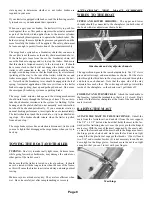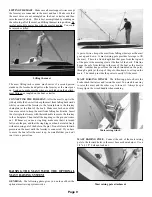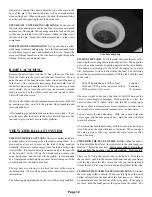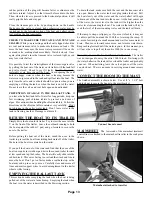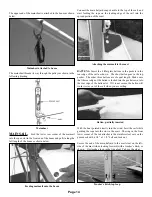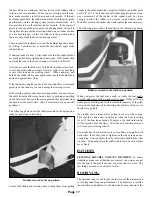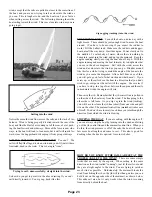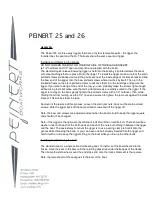
EXTERIOR FINISH.
The fiberglass finish should be protected
in the same manner as an automobile finish. An occasional pol-
ishing and waxing (with any good quality automotive polish and
wax) will keep the surface in excellent condition. If the boat is
left in the water (either fresh or salt water), apply a coat of top
grade anti-fouling bottom paint with an 18 mil thick (.018”) epoxy
undercoat. Without good bottom paint and epoxy primer, the
white gel coat exterior surface may blister.
WIRING DIAGRAM
TRAILER MAINTENANCE
GENERAL.
A good periodic inspection and clean up can add
years to the trailer’s life.
Frequently check the trailer to insure that all bolts and nuts are
tight, that all welds look solid, and that there are no cracks or
bends in the trailer structure. Inspect tires for wear, cuts, bad
bruises.
Replace tires if they become worn or damaged.
All of the maintenance and operation procedures mentioned are
very important as there are no warranties of any kind on brake
systems for boat trailers.
Always hose the trailer down with fresh water after immersing in
salt water. Salt water is very corrosive, and removing it will add
years to the life of the trailer.
AXLE MAINTENANCE.
Buy a small grease gun for the hubs
and use a high quality multi-purpose non-fibrous grease, similar
to the grease used in automobile wheel bearings. Put in enough
grease to move the spring loaded piston about 1/8” outward from
its seated position. Check the lubricant level in the hub by press-
ing the edge of the spring loaded piston. If you can move or rock
the piston, the hub has sufficient grease. If it cannot be moved,
add grease with the grease gun. Do not overfill.
TRAILER LIGHT CARE.
All lights should be removed before
putting the trailer in the water.
SURGE BREAKS.
Please read the surge brake instructions that
are included in the rig box.
LIMITED WARRANTY
MacGregor Yacht Corp. makes the following warranty to pur-
chasers:
SAILBOATS AND SAILBOAT PARTS AND EQUIPMENT.
For a period of two years from the date of sale to the first use pur-
chaser, MacGregor Yacht Corp. will, through its selling dealers,
repair or replace any sailboat part or sailboat equipment manufac-
tured by MacGregor which is proven to MacGregor’s satisfaction
to be defective by reason of faulty workmanship or material.
TRAILERS AND TRAILER PARTS AND EQUIPMENT.
For six months from the date of sale to the first use purchaser,
MacGregor Yacht Corp. will, through its dealers, repair or replace
any trailer part or trailer equipment manufactured by MacGregor
which is proven to MacGregor’s satisfaction to be defective by
reason of faulty workmanship or material.
THIS WARRANTY SHALL NOT APPLY TO THE FOL-
LOWING
:
(1) All items determined by MacGregor to be the responsibility of
the dealer in launching or otherwise handling or preparing a new
boat or vessel.
(2) All items installed by the dealer or anyone else other than
MacGregor.
(3) Any failure resulting from lack of maintenance, normal wear
and tear, negligent operations or maintenance. Negligent opera-
tion includes, but is not limited to, failure to properly and com-
pletely fill the water ballast tank when sailing, failure to empty the
water ballast tank before trailering, failure to heed adverse weath-
er warnings, and failure to use care when operating the boat near
sources of electrical power.
(4) All accessories or equipment not manufactured by
MacGregor. Any warranty furnished by the manufacturer, if pos-
sible, will be passed on to the boat owner.
(5) Trailer brake systems and trailer lighting systems.
(6) Exterior paint and gel coat finishes. Although we use the
finest finishes available in the industry, they cannot be warranted
because they are affected by climate and use conditions beyond
the control of MacGregor Yacht Corp.
(7) Any other person than the first use purchaser of the boat.
(8) Any boat or part manufactured by MacGregor which shall
have been altered in any way so as to impair its original charac-
teristics.
The foregoing warranties are made in lieu of all other warranties,
obligations, liabilities, or representation on the part of MacGregor,
and the purchaser waives all other warranties, guaranties, or lia-
bilities, expressed or implied, arising by law or otherwise, includ-
ing without limitations any liability of MacGregor for consequen-
tial damages.
The purchaser should understand that the dealer is not an agent of
Page 20
Summary of Contents for 26 M
Page 28: ...Page 28...



